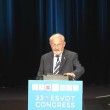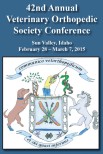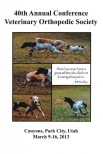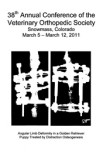 Dr. Randy Acker
Dr. Randy Acker
Associate Professor, Orthopedics
Received his education at Colorado State University in Fort Collins, Colorado. After graduation in 1979 he moved to Sun Valley, Idaho and joined a mixed animal practice.
Orthopedic interest started in veterinary school preparing skeletons and bone models for professors. Orthopedic interest led him to many specialized teaching courses including hip replacement (CFX, BFX, and KYON), elbow replacement (Iowa State and Lewis), ACL repair (TPLO and TTA), spine and most fracture management systems. Currently he practices in Sun Valley doing orthopedic referral cases. He practices with his two brothers who are veterinarians and will soon be joined by two daughters who are in veterinary school. Recently he developed the TATE Elbow™ .
What is the TATE Elbow™?
It is a minimally invasive resurfacing arthroplasty of the canine elbow.

What stimulated your interest in elbow replacement?
My Labrador “Tate” had severe elbow arthritis and did not respond to any treatments. He lived to thirteen years of age and was severely lame for seven of them.
What were the major decisions that you made in development of the TATE Elbow™ System?
An important decision was to realize that if I wanted it to go from concept to implant, I would need to hire an engineer. I was visiting my daughter in Boulder, Colorado where her roommate, Greg Van Der Muelen, was a senior in biomedical engineering. Greg needed a senior paper so we started working on the elbow concept. About one year later I hired him full time to help with the elbow project. It was amazing to realize that an implant or instrument design could go from the computer to an SLA prototype or actual component in three to four days.
Another important decision was to know that once the concept was finished and the patent was filed, I needed a company to license, develop, and market the concept. Chris Sidebothum of BioMedtrix was essential in manufacturing and assistance with product development. I felt that Greg, Chris and I were the right team.

What design considerations were used in the development of the system?
After attending the courses and reviewing the past systems, I had some general concepts. I wanted a medial approach due to lateral luxations seen with other systems. A minimally invasive concept was essential to reduce patient morbidity and decrease the post operative aftercare. After some loose implants with cemented hip systems, I chose a non-cemented system for the elbow.

What was the major breakthrough in the development?
I remember the day the mill and drill concept was developed and it just felt right. We had attempted bone preparation with saws and spine burrs, and we finally started talking about milling. Custom end mills were developed and the cuts were fast and accurate. We realized that drilling for implant attachment to bone, then milling, would allow preparation of both sides of the joint simultaneously without disarticulation. The collateral ligaments were preserved in their original length with no impingement through the range of motion. The cartridge concept soon followed, and I felt we were on the way. After implanting many cadavers with different SLA prototypes, our tenth prototype felt right in the cadaver. We tested for full range of motion with stability in extension and flexion.

What is novel about the concept?
Simultaneous preparation of both joint surfaces using the axis of rotation as the mill datum has not been done before. The other unique aspect of the patent is inserting both components of an arthroplasty together as a cartridge. These concepts potentially provide for improved alignment of the implants, reduced surgical trauma and reduced surgical time.
When was the first clinical case?
In July of 2007 we implanted “Otis” who was an older Labrador with many orthopedic problems. I was apprehensive, with a client owned patient, but the owner was aware of the experimental nature of the case and was frustrated with his dog’s inability to move. With two engineers in the room and a three hour surgery, I was relieved to get the implant in. I was more relieved when he walked out of the clinic three days later bearing weight well. I had researched other systems that had been discontinued after only a few cases. I was recently contacted by the owner requesting the other elbow be replaced.

How many have you done?
We have seven cases to date with no explants, fusions or amputations.
Will courses be offered?
The first course was done in Houston at Dr. Bill Liska’s Practice. It was a select group of twenty four surgeons who are experienced with joint replacement. I feel the lab went well with most surgeons implanting the sawbones and cadavers accurately. The second course is scheduled at Michigan State University in April. A course in Europe is planned in conjunction with the ESVOT Congress in Munich next September.
Do you have reservations about teaching the system?
I feel it needs to be looked at and worked on by individuals qualified to do the proper studies. I am excited to see force plate analysis, kinematic studies, histomorphometry, and evaluation by others. A general release is not planned at this point. Long term data is needed as we only have a few patients out about nine months. I don’t think any surgery is static, however, I hope the concept will bear the test of time producing an implant comparable to the success of total hip replacement.















